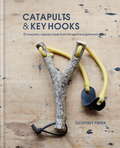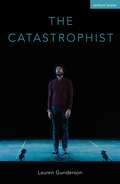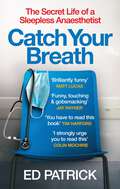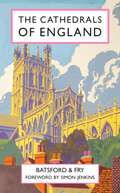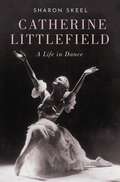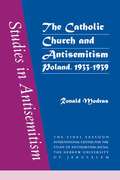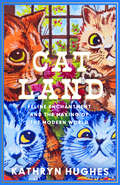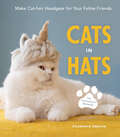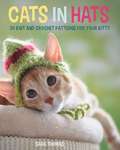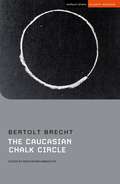- Table View
- List View
Catapults & Key Hooks: Everyday objects made from foraged and gathered wood
by Geoffrey FisherWhether building a bee hotel to help your garden's ecosystem thrive, crafting a catapult, whistle, skipping rope or cup and ball game to give away, or making a key hook or cobweb brush to organise your home, the result of each will be entirely unique while also effortlessly stylish.All basic woodworking techniques are covered, plus Geoffrey also shows how best to prepare materials, including checking for disease, drying and stripping bark, and gives a detailed guide on your essential tool kit - what to have, how to handle your tools safely and how to maintain everything to the highest standard -meaning anyone can pick up Catapults & Key Hooks and dive straight into the world of Geoffrey's designs.
Catastrophe in the Making: The Engineering of Katrina and the Disasters of Tomorrow
by William R. Freudenburg Robert Gramling Shirley Laska Kai T. EriksonBased on the false promise of widespread prosperity, communities across the U.S. have embraced all brands of “economic development” at all costs. In Louisiana, that meant development interests turning wetlands into shipping lanes. By replacing a natural buffer against storm surges with a 75-mile long, obsolete canal that cost hundreds of millions of dollars, they guided the hurricane into the heart of New Orleans and adjacent communities. The authors reveal why, despite their geographic differences, California and Missouri are building—quite literally—toward similar destruction.Too often, the U.S. “growth machine” generates wealth for a few and misery for many. Drawing lessons from the most expensive “natural” disaster in American history, Catastrophe in the Making shows why thoughtless development comes at a price we can ill afford.
The Catastrophist (Modern Plays)
by Lauren GundersonHow do you plan for a catastrophe? Virologist Nathan Wolfe, named one of TIME's 100 Most Influential People in the World for his work tracking viral pandemic outbreaks, proposed pandemic insurance years before the novel coronavirus outbreak. No one bought it. Now, in a post-COVID world, we hear his story. A time-jumping tale based on the life and work of Nathan Wolfe (who also happens to be the playwright's husband). Though not a play about COVID19, it is a true story of a pandemic expert. An deep dive into the profundities of scientific exploration, the lengths one goes for love and family, the bracing truths of fatherhood and discovery, and the harrowing realities of facing your own mortality, The Catastrophist is a world premiere theatrical experience built of and for this moment in time.
The Catastrophist (Modern Plays)
by Lauren GundersonHow do you plan for a catastrophe? Virologist Nathan Wolfe, named one of TIME's 100 Most Influential People in the World for his work tracking viral pandemic outbreaks, proposed pandemic insurance years before the novel coronavirus outbreak. No one bought it. Now, in a post-COVID world, we hear his story. A time-jumping tale based on the life and work of Nathan Wolfe (who also happens to be the playwright's husband). Though not a play about COVID19, it is a true story of a pandemic expert. An deep dive into the profundities of scientific exploration, the lengths one goes for love and family, the bracing truths of fatherhood and discovery, and the harrowing realities of facing your own mortality, The Catastrophist is a world premiere theatrical experience built of and for this moment in time.
Catch Your Breath: The Secret Life of a Sleepless Anaesthetist
by Ed Patrick'Ed's journey is funny, sad, harrowing, hilarious... I STRONGLY URGE YOU TO READ THIS.' - Colin Mochrie A gut punch of a memoir by a doctor - and comedian - whose job is to keep people alive by putting them to sleep.Ed Patrick is an anaesthetist.Strong drugs for his patients, strong coffee for him. But it's not just sleep-giving for this anaesthetist, as he navigates emergencies, patients not breathing for themselves and living with a terrifying sense of responsibility. It's enough to leave anyone feeling numb.But don't worry, there's plenty of laughing gas to be had.'Very funny, very timely, scary in places. Ed writes with wit, insight, surprise and pathos. He is cutting his teeth in anaesthetics, taking people as close to death as you can take them, and then trying to wake them up again. And makes it funny. A joy to read.' - Phil Hammond
Catching Bullets
by Mark O’ConnellWhen Jimmy O'Connell took a job as chauffeur for 007 producers Eon Productions, it would not just be Cubby Broccoli, Roger Moore and Sean Connery he would drive to James Bond his grandson Mark swiftly hitched a metaphorical ride too. In Catching Bullets: Memoirs of a Bond Fan, Mark O'Connell takes us on a humorous journey of filmic discovery where Bond films fire like bullets at a Thatcher era childhood, closeted adolescence and adult life as a comedy writer still inspired by that Broccoli movie magic. Catching Bullets is a unique and sharply-observed love-letter to James Bond, Duran Duran title songs and bolting down your tea quick enough to watch Roger Moore falling out of a plane without a parachute.
Caterina Sforza and the Art of Appearances: Gender, Art and Culture in Early Modern Italy (Women and Gender in the Early Modern World)
by Joyce de VriesIn the first major book in four decades on Caterina Sforza (1463-1509), Joyce de Vries investigates the famous noblewoman's cultural endeavors, and explores the ways in which gender, culture, and consumption practices were central to the invention of the self in early modern Italy. Sforza commissioned elaborate artistic and architectural works, participated in splendid civic and religious rituals, and collected a dazzling array of clothing, jewelry, and household goods. By engaging in these realms of cultural production, de Vries suggests, Sforza manipulated masculine and feminine norms of behavior and effectively promoted her social and political agendas. Drawing on visual evidence, inventories, letters, and contemporary texts, de Vries offers a penetrating new interpretation of women's contributions to early modern culture. She explains the correlations between prescriptive literature and women's actions and reveals the mutability of gender roles in the princely courts. De Vries's analysis of Sforza's posthumous legend suggests that what we see as "the Renaissance" was as much a historical invention as a coherent moment in historical time.
Caterina Sforza and the Art of Appearances: Gender, Art and Culture in Early Modern Italy (Women and Gender in the Early Modern World)
by Joyce de VriesIn the first major book in four decades on Caterina Sforza (1463-1509), Joyce de Vries investigates the famous noblewoman's cultural endeavors, and explores the ways in which gender, culture, and consumption practices were central to the invention of the self in early modern Italy. Sforza commissioned elaborate artistic and architectural works, participated in splendid civic and religious rituals, and collected a dazzling array of clothing, jewelry, and household goods. By engaging in these realms of cultural production, de Vries suggests, Sforza manipulated masculine and feminine norms of behavior and effectively promoted her social and political agendas. Drawing on visual evidence, inventories, letters, and contemporary texts, de Vries offers a penetrating new interpretation of women's contributions to early modern culture. She explains the correlations between prescriptive literature and women's actions and reveals the mutability of gender roles in the princely courts. De Vries's analysis of Sforza's posthumous legend suggests that what we see as "the Renaissance" was as much a historical invention as a coherent moment in historical time.
Cathedrals of Britain (Shire Library)
by David PepinCathedrals are awe-inspiring buildings. Most are grand medieval structures, while others appear simple and unpretentious – yet all were designed to reflect the glory of God and have a profound impact on us. As trailblazers of architectural development, each cathedral has distinct individual features – such as the powerful Norman Romanesque west towers of Durham, the unique octagonal tower at Ely, and the daring late Gothic finery and spaciousness at Gloucester. In this lavishly illustrated guide to cathedrals from Bangor to York, with profiles of Roman Catholic and Scottish cathedrals, David Pepin outlines the evolution of architectural style, each building's key features, and the ongoing story of daily worship, wide-ranging ministry, conservation, the new work of craftspeople, and the increasing numbers of pilgrims and visitors.
Cathedrals of Britain (Shire Library #831)
by David PepinCathedrals are awe-inspiring buildings. Most are grand medieval structures, while others appear simple and unpretentious – yet all were designed to reflect the glory of God and have a profound impact on us. As trailblazers of architectural development, each cathedral has distinct individual features – such as the powerful Norman Romanesque west towers of Durham, the unique octagonal tower at Ely, and the daring late Gothic finery and spaciousness at Gloucester. In this lavishly illustrated guide to cathedrals from Bangor to York, with profiles of Roman Catholic and Scottish cathedrals, David Pepin outlines the evolution of architectural style, each building's key features, and the ongoing story of daily worship, wide-ranging ministry, conservation, the new work of craftspeople, and the increasing numbers of pilgrims and visitors.
Cathedrals of Urban Modernity: Creation of the First Museums of Contemporary Art (Routledge Revivals)
by J. Pedro LorenteFirst published in 1998, this volume explores the expanding wave of a new kind of museums of contemporary art in the nineteenth and early twentieth centuries. Lorente examines their ‘coming of age’ and the weight of their museological legacy, arguing that the establishment of great national museums of art at London and Paris radiated out, carrying their influence with it. This book emerged as part of a series on towns and cities and has a focus on London and Paris as centres of artistic innovation.
Cathedrals of Urban Modernity: Creation of the First Museums of Contemporary Art (Routledge Revivals)
by J. Pedro LorenteFirst published in 1998, this volume explores the expanding wave of a new kind of museums of contemporary art in the nineteenth and early twentieth centuries. Lorente examines their ‘coming of age’ and the weight of their museological legacy, arguing that the establishment of great national museums of art at London and Paris radiated out, carrying their influence with it. This book emerged as part of a series on towns and cities and has a focus on London and Paris as centres of artistic innovation.
Catherine Littlefield: A Life in Dance
by Sharon SkeelWhile she is best remembered today as founder of the Philadelphia Ballet and the director and driving force behind the famous Littlefield School of Ballet, from which Balanchine drew the nucleus for his School of American Ballet, Catherine Littlefield (1905-51) and her oeuvre were in many ways emblematic of the full representation of dance throughout entertainments of the first half of the 20th century. From her early work as a teenager dancing for Florenz Ziegfeld to her later work in choreographing extravagant ice skating shows, a remarkable dance with 90 bicyclists for the 1940 World's Fair, and on television as resident choreographer for The Jimmy Durante Show, Littlefield was amongst the first choreographers to bring concert dance to broader venues, and her legacy lives on today in her enduring influence on generations of American ballet dancers. As the first biography of Littlefield, Catherine Littlefield: A Life in Dance traces her life in full from birth through childhood experiences dancing on the Academy of Music's grand stage, and from her foundation of the groundbreaking Philadelphia Ballet Company in 1935 to her later work in television and beyond. Littlefield counted among her many glamorous friends and colleagues writer Zelda Fitzgerald, conductor Leopold Stokowski, and composer Kurt Weill. This biography also provides an engrossing portrait of the remarkable Littlefield family, many of whom were instrumental to Catherine's success. With the unflagging support of her generous husband and indomitable mother, Littlefield gave shape to the course of American ballet in the 20th century long before Balanchine arrived in the United States.
Catherine Littlefield: A Life in Dance
by Sharon SkeelWhile she is best remembered today as founder of the Philadelphia Ballet and the director and driving force behind the famous Littlefield School of Ballet, from which Balanchine drew the nucleus for his School of American Ballet, Catherine Littlefield (1905-51) and her oeuvre were in many ways emblematic of the full representation of dance throughout entertainments of the first half of the 20th century. From her early work as a teenager dancing for Florenz Ziegfeld to her later work in choreographing extravagant ice skating shows, a remarkable dance with 90 bicyclists for the 1940 World's Fair, and on television as resident choreographer for The Jimmy Durante Show, Littlefield was amongst the first choreographers to bring concert dance to broader venues, and her legacy lives on today in her enduring influence on generations of American ballet dancers. As the first biography of Littlefield, Catherine Littlefield: A Life in Dance traces her life in full from birth through childhood experiences dancing on the Academy of Music's grand stage, and from her foundation of the groundbreaking Philadelphia Ballet Company in 1935 to her later work in television and beyond. Littlefield counted among her many glamorous friends and colleagues writer Zelda Fitzgerald, conductor Leopold Stokowski, and composer Kurt Weill. This biography also provides an engrossing portrait of the remarkable Littlefield family, many of whom were instrumental to Catherine's success. With the unflagging support of her generous husband and indomitable mother, Littlefield gave shape to the course of American ballet in the 20th century long before Balanchine arrived in the United States.
The Catholic Church and Antisemitism
by Ronald ModrasInterwar Poland was home to more Jews than any other country in Europe. Its commonplace but simplistic identification with antisemitism was due largely to nationalist efforts to boycott Jewish business. That they failed was not for want of support by the Catholic clergy, for whom the ''Jewish question'' was more than economic. The myth of a Masonic-Jewish alliance to subvert Christian culture first flourished in France but held considerable sway over Catholics in 1930s Poland as elsewhere. This book examines how, following Vatican policy, Polish church leaders resisted separation of church and state in the name of Catholic culture. In that struggle, every assimilated Jew served as both a symbol and a potential agent of security. Antisemitism is no longer regarded as a legitimate political stance. But in Europe, the United States, and the Middle East, the issues of religious culture, national identity, and minorities are with us still. This study of interwar Poland will shed light on dilemmas that still effect us today.
The Catholic Church and Antisemitism
by Ronald ModrasInterwar Poland was home to more Jews than any other country in Europe. Its commonplace but simplistic identification with antisemitism was due largely to nationalist efforts to boycott Jewish business. That they failed was not for want of support by the Catholic clergy, for whom the ''Jewish question'' was more than economic. The myth of a Masonic-Jewish alliance to subvert Christian culture first flourished in France but held considerable sway over Catholics in 1930s Poland as elsewhere. This book examines how, following Vatican policy, Polish church leaders resisted separation of church and state in the name of Catholic culture. In that struggle, every assimilated Jew served as both a symbol and a potential agent of security. Antisemitism is no longer regarded as a legitimate political stance. But in Europe, the United States, and the Middle East, the issues of religious culture, national identity, and minorities are with us still. This study of interwar Poland will shed light on dilemmas that still effect us today.
Catholic Religious Poets: From Southwell to Crawshaw
by Anthony D. CousinsWhile so much has been written about the English Protestant religious poets of the late 16th and earlier 17th centuries, there is relatively little study on the Catholic religious poets. Cousins fills this gap with his critical history of the Catholic religious poets major phase in the English Renaissance. In studying the Catholic religious poets from Southwell to Crashaw, this book focuses on the interplay in their verse between natively English and Counter-Reformation devotional literary traditions. Cousins puts forward particularly two arguments: that most of the more important Catholic poets write verse which expresses a Christ-centred vision of reality; that the divine agape receives almost as much attention in the Catholic poets' verse as does devout eros. In The Catholic Religious Poets Cousins defends the work of the Catholic religious poets arguing that this literary tradition deserves closer examination and higher valuation than it has usually been given.
Catholics in the Movies
by Colleen McDannellCatholicism was all over movie screens in 2004. Mel Gibson's The Passion of the Christ was at the center of a media firestorm for months. A priest was a crucial character in the Academy Award-winning Million Dollar Baby. Everyone, it seemed, was talking about how religious stories should be represented, marketed, and received. Catholic characters, spaces, and rituals have been stock features in popular films since the silent era. An intensely visual religion with a well-defined ritual and authority system, Catholicism lends itself to the drama and pageantry of film. Moviegoers watch as Catholic visionaries interact with the supernatural, priests counsel their flocks, reformers fight for social justice, and bishops wield authoritarian power. Rather than being marginal to American popular culture, Catholic people, places, and rituals are all central to the world of the movie. Catholics in the Movies begins with an introductory essay that orients readers to the ways that films appear in culture and describes the broad trends that can be seen in the movies' hundred-year history of representing Catholics. Each chapter is written by a noted scholar of American religion who concentrates on one movie engaging important historical, artistic, and religious issues. Each then places the film within American cultural and social history, discusses the film as an expression of Catholic concerns of the period, and relates the film to others of its genre. Tracing the story of American Catholic history through popular films, Catholics in the Movies should be a valuable resource for anyone interested in American Catholicism and religion and film.
Cathy Come Home (BFI TV Classics)
by S. Lacey?Cathy Come Home is one of the most influential and highly-regarded UK television dramas. First screened in 1966, it was a devastating indictment of government policy towards homelessness, and a powerful defence of the homeless. More than forty years on, it is still cited as one of the most important television dramas of all time. Screened in the BBC's groundbreaking Wednesday Play anthology series, Cathy was the first single UK television play to be made on film and shot substantially on location. Directed by Ken Loach and produced by Tony Garnett, the film had an immediate impact, recording unprecedented audience approval ratings and generating controversy in the press. Its appearance coincided with the launch of the housing charity Shelter, which used an image of Carol White (the actress who played Cathy) as part of a poster campaign that helped the charity become a national campaigning body on behalf of the homeless. Cathy was also formally innovative. Based on the writer Jeremy Sandford's meticulous research, it combined a variety of documentary techniques in a dramatic context, and was one of the first in a long line of controversial 'documentary dramas' associated with the UK single play.Stephen Lacey provides the first book-length account of Cathy Come Home and offers a close textual reading, focusing on its main themes and storytelling techniques. He analyses the film and its production history, outlining how it came to the screen and placing it in its social and cultural context, and charts its media reception and how it became a national phenomenon. Lacey also explores how Cathy draws on a range of filmic and dramatic traditions, including the French New Wave and contemporary documentary and current affairs, and explores the anti-rhetorical style of 'non-acting' that has come to be associated with Loach's work.
Cathy Come Home (Open Forum Ser.)
by Jeremy SandfordSandford's 'Cathy Come Home' details the issue of homelessness and the life of a young woman in 1960s London as she moves from her own home, to council accomodation, and finally emergency accomodation for the homeless before being evicted and her children taken into care. It is a harrowing and emotive screenplay of the '60s television docu-drama which caused social upheaval upon its transmission and caused the homeless charity 'Shelter' to be formed. Although often distressing to read, I cannot recommend this book highly enough as it truly will change the way you look at the issue. Perhaps the most tragic thing of all is the preface to the re-printed edition which discusses how the issue of homelessness is now worse today than it was when Sandford decided to document it with this amazing play.
Catland: Feline Enchantment and the Making of the Modern World
by null Kathryn Hughes'Remarkable' Literary Review 'Startlingly original' Amanda Foreman Some called it a craze. To others it was a cult. Join prize-winning historian Kathryn Hughes to discover how Britain fell in love with cats and ushered in a new era. ‘He invented a whole cat world’ declared H. G. Wells of Louis Wain, the Edwardian artist whose anthropomorphic kittens made him a household name. His drawings were irresistible but Catland was more than the creation of one eccentric imagination. It was an attitude – a way of being in society while discreetly refusing to follow its rules. As cat capitalism boomed in the spectacular Edwardian age, prized animals changed hands for hundreds of pounds and a new industry sprung up to cater for their every need. Cats were no longer basement-dwelling pest-controllers, but stylish cultural subversives, more likely to flaunt a magnificent ruff and a pedigree from Persia. Wherever you found old conventions breaking down, there was a cat at the centre of the storm. Whether they were flying aeroplanes, sipping champagne or arguing about politics, Wain’s feline cast offered a sly take on the restless and risky culture of the post-Victorian world. No-one experienced these uncertainties more acutely than Wain himself, confined to a mental asylum while creating his most iconic work. Catland is a fascinating and fabulous unravelling of our obsession with cats, and the man dedicated to chronicling them. 'If a Louis Wain cat were reading this book, he would raise his topper in tribute’ The Times 'Brilliantly researched and unforgettable' Miranda Seymour 'Consistently fascinating … A tremendous literary feat in which we learn about Victorian sociology through the work of a remarkably unique artist' Kirkus, starred review
Cats in Hats
by Rojiman UmatanFinally, there’s a headwear solution for fashionable felines – and a practical use for accumulated shed hair. Cats in Hats contains step-by-step instructions for constructing stylish hats out of excess fur, so your cat will soon be the belle of the furball as they transform into a magical unicorn, ferocious lion or even a birthday cake!
Cats in Hats: 30 Knit and Crochet Hat Patterns for Your Kitty
by Sara ThomasDeck your cats out in hats that suit their many personalities! With The Punk Mohawk for edgier cats, The Unicorn for cats who are having identity issues, and The Cat in the Hat for any cat that loves great literature, there is a pattern in this book for every feline friend in your home. Complete with a breakdown of skill level and method of working (knit or crochet), suggestions for yarns, and written patterns and charts where necessary, you'll be able to whip up amazing headwear, whatever your cat's character. With the adorable color photos and helpful illustrations throughout, these hat patterns will be both exciting and easy to create. It's fun, it's addictive, and it's deliciously purr-fect from start to finish!
The Caucasian Chalk Circle (Student Editions)
by Bertolt BrechtBrecht projects an ancient Chinese story onto a realistic setting in Soviet Georgia. In a theme that echoes the Judgment of Solomon, two women argue over the possession of a child. Thanks to the unruly judge, Azdak (one of Brecht's most vivid creations) natural justice is done and the peasant Grusha keeps the child she loves, even though she is not its mother.Written while Brecht was in exile in the United States during the Second World War, The Caucasian Chalk Circle is a politically charged, much-revived and complex example of Brecht's epic theatre.This new Student Edition contains introductory commentary and notes by Kristopher Imbriggota from the University of Puget Sound, US, offering a much-needed contemporary perspective on the play. The introduction covers:- narrative structure: play about a play within a play ("circle")- songs and music- justice and social systems- context: Brecht, exile, WWII, socialism- notions of collective and class- fable and story adaptation, folk fairy tale
